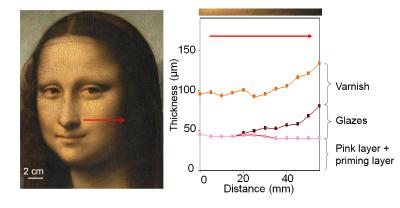- Home
- News
- General News
- New light on Leonardo...
New light on Leonardo Da Vinci’s faces
15-07-2010
PRESS RELEASE - Paris, 15 July - How did Leonardo Da Vinci manage to paint such perfect faces? For the first time a quantitative chemical analysis has been done on seven paintings from the Louvre Museum (including the Mona Lisa) without extracting any samples. This shows the composition and thickness of each layer of material laid down by the painter. The results reveal that, in the case of glazes, thin layers of 1 to 2 micrometers have been applied. The study, led by the team of Philippe Walter, of the Laboratoire du Centre de Recherche et de Restauration des Musées de France (LC2RMF, CNRS/Ministère de la culture et de la communication), with the collaboration of the ESRF (which provided the data analysis) and the support of the Louvre Museum.
Share
Leonardo Da Vinci's paintings fascinate, partly due to a range of subtle optical effects that blur outlines, soften transitions and blend shadows like smoke. Known as "sfumato", this technique is not only the result of the genius of the artist but also of technical innovations at the beginning of the 16th century. Minute observations, optical measurements and reconstitutions have already described the sfumato, but new analysis can confirm the procedure of this technique, especially related to how the gradation is done.
For the first time, Philippe Walter (LC2RMF) and his team, in collaboration with the ESRF and the Louvre Museum, have brought new insight on the sfumato thanks to a quantitative chemical study of the different painted layers. Seven paintings of Leonardo Da Vinci have been analysed without extraction, directly in the rooms of the Louvre Museum (Virgin of the Rocks, Mona Lisa, Saint John the Baptist,
Annunciation, Bacchus, Belle Ferronnière, Saint Anne, the Virgin, and the Child). The scientists concentrated on the study of the faces because they have the characteristics of the sfumato. They used a technique called X-ray fluorescence with a portable X-ray generator to determine the composition and thickness of each layer in nine faces (including Mona Lisa's) painted by Da Vinci throughout 40 years of career.
 |
|
| Photo taken during the measurements on the Mona Lisa. X-ray fluorescence spectrometry was done directly on the paintings in the Louvre Museum. Copyright: V.A. Solé/ESRF |
Representation of the superposition of layers in paintings in the face of Mona Lisa, on one light zone near the nose and the darker shadow of the hair. After treating the data, the thickness and concentration of pigments in the different layers. Copyright: C2RMF. |
The scientists have also found different recipes used by Da Vinci to do the shadows on the faces. These recipes are characterized by a technique (the use of glaze layers or a very thin paint) and by the nature of the pigments or additives. In the case of the glazes, thin layers of 1 to 2 micrometres were applied to obtain a total thickness of no more than 30 to 40 micrometres. The results obtained in this study help to understand Da Vinci's search towards making his art look alive.
Reference:
Viguerie L. et al, Revealing the sfumato technique of Leonardo da Vinci by
X-ray Fluorescence Spectroscopy, Angewandte Chemie International
Edition, 2010, 49, DOI: 10.1002/anie.201001116.
Notes to the editors:
A glaze is a fine, translucid layer, mainly organic, which contains a
little bit of pigment. The superposition of glazes allows to create
depth and volume.
X-ray fluorescence spectroscopy is a chemical analytical method. It
consists of making lighter an area in a painting using X-rays. Later,
the material emits other X-rays (fluorescence) which are characteristic
of the studied area.
Top image: Photo taken during the measurements on the Mona Lisa : X-ray fluorescence spectrometry was done directly on the paintings in the Louvre Museum. Copyright: V.A. Solé/ESRF



